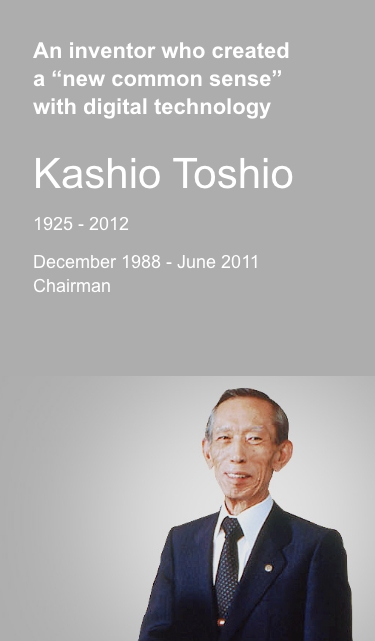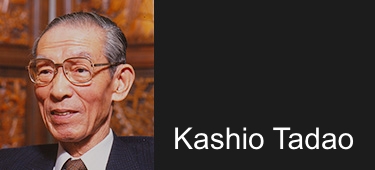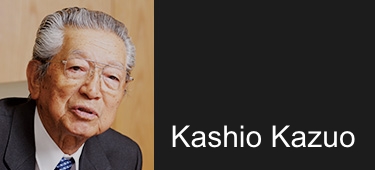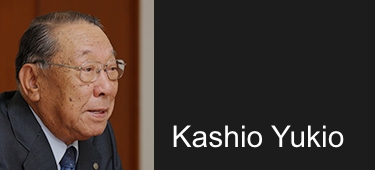


As the second eldest of the Kashio brothers, Kashio Toshio was an inventor who developed the calculators, watches, and electronic musical instruments that would constitute the core businesses of Casio. He was an inventor who used digital technology to create products that would change the world.
Toshio was always thinking, devising a method to use “tsurukame-zan” calculation all by himself. He read Thomas Edison’s biography at the age of 12 and resolved to become an inventor himself. His passion for inventions grew stronger when he joined the Ministry of Communications in 1940. The reason he joined his older brother Tadao’s company was because he wanted to help his brother out by inventing new things instead of just relying on built-to-order manufacturing.
Afterward, beginning with the development of the world’s first compact all-electric calculator, the 14-A, he created numerous information devices that would change people’s way of living, including the Casiotron, the world’s first digital watch with an automatic calendar, electronic musical instruments, etc. As the head of development at Casio, he continued releasing new products to the world.
Toshio has left us the words, “Inventions are created with 1% inspiration, 49% effort, and 50% providence.” The “50% providence” refers to him being blessed with good brothers. He was able to shine as an inventor as a result of his brothers, who would turn Toshio’s inventions into reality.
Born in Tokyo on January 1, 1925. After graduating from the Electrical Engineering School (current Tokyo Denki University), he joined the Ministry of Communications in 1940. He then joined Kashio Seisakujo in 1946. After serving as an engineering manager and head of the development headquarters at Casio, he became Chairman in 1988. He became Honorary Chairman in 2011. He is a recipient of the Medal with Blue Ribbon (1984) and the recipient of an honorary doctorate from Tokyo Denki University (2007).


-


-
Toshio would often visit the securities firm where his older sister worked. This was so he could ascertain what was necessary in the workplace by observing his sister at her job. “I must create inventions that make users aware of needs they had not noticed before,” he thought. Toshio, who was very perceptive, successfully discovered the need for “a calculator that would provide the right answer,” which the employees at the securities firm were not yet aware of. And, utilizing digital technology, he created a computational circuit that would produce no errors and that was easy to use and small enough to place near you, thus fulfilling this need.
Calculators, watches, electronic musical instruments… All of these inventions by Toshio, which became the core businesses of Casio, were the origin of a new “common sense.” Toshio said, “The proverb ‘Necessity is the mother of invention’ is already obsolete. You will be too late if you only create what users want. In fact, ‘invention is the mother of necessity.’” Creating things that will make people happy and that have never been made before. The history of Toshio’s inventions is full of truly necessary devices that nobody had yet thought of.
-


-
Toshio had developed the relay calculator and was headed for its presentation in Sapporo together with his little brother, Kazuo. However, at Haneda Airport, they discovered that the calculator exceeded the luggage size limit. With no other choice, they disassembled and sent it, but unfortunately, it could not run properly at the presentation. Toshio felt guilty due to thinking he had betrayed the trading company representative who had helped the brothers and the people who had come to the venue. But then, he recalled a vague image he had had in his mind ever since he had been a small child. “There is a spring inside the human body. It compresses when people are in pain. But there are no springs that are always compressed, they must always return to their original shape. I am currently compressed due to immense pressure, but all I have to do is extend as much as I can.” Even if you fail, you must try to succeed once again. That was the policy of Kashio Toshio, the inventor.

-


-
Japan’s first electronic calculator (solenoid model) was invented by Toshio and manufactured by his older brother Tadao with the help of his younger brothers Kazuo and Yukio. However, they were told they were “five years too late” from a representative of a trading company handling calculators. The invention they had devoted all of their hearts to had been rejected. Regardless, Toshio immediately switched gears toward the relay method, completing the world’s first compact all-electric calculator, the 14-A, in less than three years. Toshio would always say, “The me of yesterday was a fool!” He used his mistakes and failures, as well as a constant stream of challenges, as fuel for his ideas. He would say, “If you are just repeating the same thing you did yesterday, you are not working. You must become capable of seeing where you have grown.”

-


-
Toshio, who loved music since he was a child, began developing electronic musical instruments at the age of 55. In order to find out what makes for a musical instrument people enjoy, Toshio began by thinking about what sound is. What is a beautiful tone? And how does it reach the human ear? While thinking, he was inspired by bird songs. “Birds play music. But why does the warbler sing the way it does? Why does the rooster sing the way it does? Because they want to hear the songs of their own species. In the same way, humans also feel pleasure hearing sounds from their own species. If we use digital technology, we can create all kinds of sounds, but I believe the sounds humans truly enjoy are those found in nature.” With this hypothesis in mind, Toshio analyzed the sounds played by these “organic instruments.” Focusing on the fact that sounds consist of vowels and consonants, he created the “vowel/consonant system” which combines both while making slight adjustments to create a single sound. This marked the completion of the Casiotone, a keyboard that allows people to enjoy the tones of various musical instruments. Toshio was an expert at hypothesizing ways to create products people would enjoy.

-


-
Toshio’s driving force was the desire to make 1 out of 0, or in other words, the genuine aspiration to create something that had never been made before. Tadao, the eldest brother, would say, “Once Toshio starts thinking about something, nothing can break his concentration. He would spend entire days immersed in thought.” Toshio’s policy on inventions was “As long as I have a pen and paper, I can invent.” Even after he reached the age of 80, he would continue to think deeply and record his thoughts on paper during many sleepless nights. Toshio continued to be an inventor throughout his entire life.
-


-
“Genius is 1% inspiration and 99% perspiration.” These words by Thomas Edison paved Toshio’s way toward becoming an inventor. Toshio would explain that “Inventions are created with 1% inspiration, 49% effort, and 50% providence.” The “providence” Toshio refers to had two additional meanings aside from its original one of divine grace. The first was “destiny,” or Heaven’s will. When he was young, Toshio considered inventing to be his duty. He would check whether something was theoretically possible and do it if it was. He also said, “Believing I would definitely succeed gave me the energy to create inventions.” As time passed, however, Toshio would come to think of inventions not as something he had to create, but rather something that came about as a result of his daily efforts. He began to feel that working for the sake of society was the driving force behind inventions. This relates to Casio’s current principles of “creativity and contribution.” The desire to contribute to society is what allows you to create things never seen before. This was the philosophy of Toshio, the inventor.








